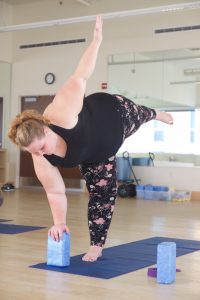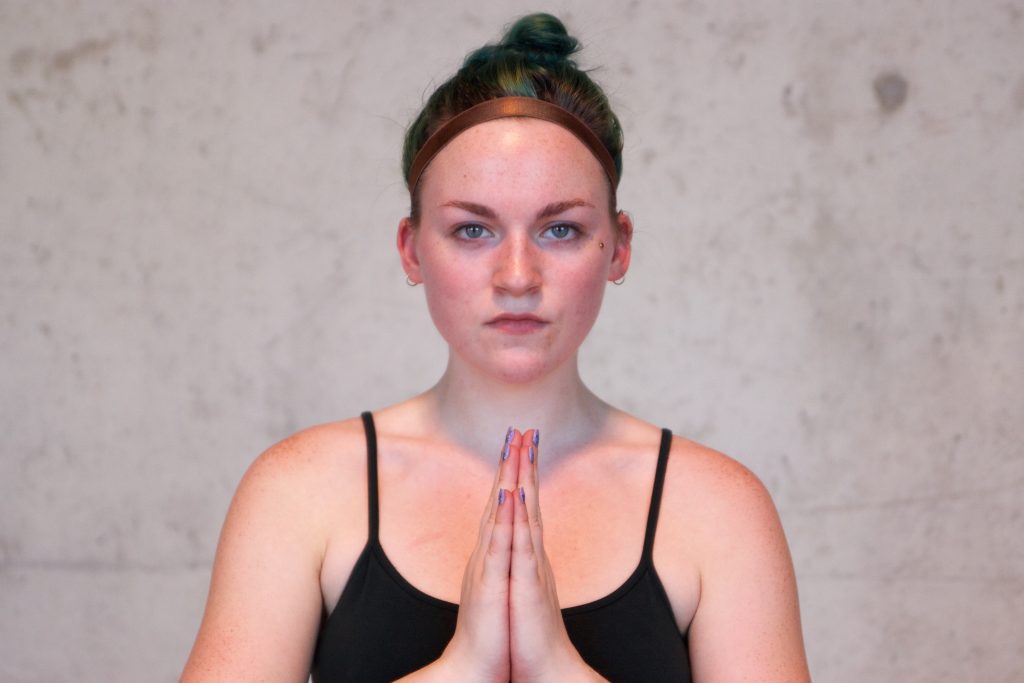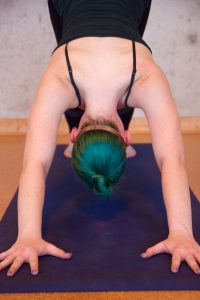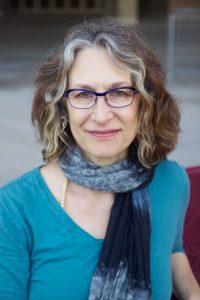Love is all-powerful and all-encompassing. Sometimes the journey to love is gradual, ebbing and flowing. In every definition of love, where is love for one’s self? Taking time out of the day to care for the ones and things we love surely is not looked down upon. In many instances, this love we feel so strongly for others is not applied to ourselves. We spread ourselves thin, always feeling tired, sometimes feeling lost. Finding a solution to this is difficult; practicing love for ourselves is often viewed as egotistical.
These are the stories of four people who realized the necessity of love and care of self and decided to take action through establishing a daily yoga practice. These four people use yoga as a practice to calm the mind and find power and control in the body. Their experiences show that yoga can help reclaim one’s body after traumatic experiences, relieve depression and anxiety, and encourage one to achieve more than one believes one can. Through the simple yet profound daily ritual of a daily yoga practice, they found the space needed to create life-changing habits of creating self-confidence, patience and ultimately, self-love.
Yoga was developed in India thousands of years ago as a “comprehensive system for well-being on all levels”: the physical, mental, emotional and spiritual, according to the Yoga Alliance.
Yoga first appeared in ancient Indian texts from 1500 B.C. About 4,000 years ago, the sage Patanjali created the the Yoga Sutras, threads of knowledge on meditation, ethics, physical postures and other yogic teachings. Within the Yoga Sutras, he mapped out the eight-limbed path that every yoga student should abide by to lead an aware, moral, meaningful and purposeful life. Nowadays, the limb that is thought of most when people hear “yoga” is the third limb, asana. Asanas are the physical postures done in a yoga class to develop the habits of discipline and concentration, two necessary skills for meditation.
It was not until the mid-19th century that Westerners began to learn about yoga. The 1960s brought more popularity of yoga to the U.S., and in the 1980s, the health benefits began to be reported.
By 2016, a study showed that 36.7 million people practice yoga in the United States. Of the 36.7 million, 72 percent of the practitioners are women. Claire MacDonald, Delight Hailman, Lisa Aarli and Jan Schaefer prove that yoga is far more than the physical asanas done in a class.

Claire MacDonald found yoga in April 2015, deciding to try it on a whim. As a survivor of self-harm, but not yet having the tools to combat feelings of deep depression and anxiety, she felt lost. “I was desperate to find something that would help me feel better.” On a day filled with particularly high stressors, she searched online for yoga in the Madison area. She attended her first class later that night.
She arrived nervous, unsure.
“I was worried about other people looking at me,” she says. “Oh my god, I’m going to look weird. I have no idea what’s going on.”
The class’s physical movements, she says, were fine. It was after the class that she realized she felt a lift in emotion, some sort of release. It was this emotional release that brought her back for a second class, for a 14th class, for a 30th class. After a few months, she noticed a mental shift. What was it that brought this change?
“Breath,” she confidently states.
Being conscious of and controlling the breath is a practice of yoga that has been practiced for thousands of years. In modern times, we see there is scientific proof behind the benefits of breath. In a study conducted eight months after the 2004 tsunami that wreaked havoc on Southeast Asia, survivors living in refugee camps were given yoga breath programs. Those given the breath work showed significantly lower levels of psychological distress. The power of breath shown in the study rings true to MacDonald.
“The breath is so important because I think that is what connects the mind and the body, which is what yoga is all about,” she says. Before finding yoga, MacDonald never knew how to breathe properly. The breath she finds that is necessary to practice the physical aspect of yoga is directly applicable to her life off of the yoga mat.
MacDonald says that learning to control the breath in yoga teaches her how to manage in stressful situations.
“I am able to calm down and breathe so deeply,” she says. “That physical component – physical knowledge – is not met by anything else. It is something that is in me … I always visualize myself exhaling bad things. I feel so much life.”
Learning to notice the correlation between breath, movement and emotion through yoga is what MacDonald needed to find love in herself.
“I learned to accept myself for who I am,” MacDonald says. “I learned the four words I go by are patience, balance, discipline and strength … When I think about how it’s affected me, those four words come up every single time.”
MacDonald now has completed over 300 yoga classes in under two years.
“Yoga helped me get rid of and recognize my feelings of depression and anxiety. If I had not started yoga, to be honest, I might not be here right now,” she says. “Yoga helped me learn to love myself again.”
Delight Hailman discovered her connection with yoga four years ago. Like many, she felt the physical benefits before she found the mental benefits. It was through her yoga classes that she realized nothing was meant to be perfect.
“Going to yoga consistently over four years, they say, ‘It’s a yoga practice, not a perfect. It’s practice, it’s practice, it’s practice.’” she says. “That was probably the biggest thing I took away, in terms of being myself.”
The power one has over the physical body in a yoga class is something Delight found confidence in. It is what helped her reclaim the ownership of her own body.
“When I was sexually assaulted, it felt like I had something that was taken away from me. My body was not mine,” Hailman says. “Yoga was an immense way to help me heal by being completely in my body and taking my body back.”

Hailman described her way of reclaiming ownership of her body as realizing she was in a relationship with her body.
“This is me and my body. We’re in a relationship, and we’re healing,” she says.
The self-care she learns from this relationship on the mat affects how she acts off the mat.
“I really understand my body,” Hailman says. “I can ask for what I want. That translates into my life, too: being able to figure out what I need and asking for it.”
 These feelings inspired Hailman to want to share the practice with others to keep yoga a safe and brave space, especially for disenfranchised groups. She has been leading yoga classes since early 2016. In her classes, she strives to assist people to find deeper releases in the asanas while empowering the students.
These feelings inspired Hailman to want to share the practice with others to keep yoga a safe and brave space, especially for disenfranchised groups. She has been leading yoga classes since early 2016. In her classes, she strives to assist people to find deeper releases in the asanas while empowering the students.
Hands-on yoga assists, actions performed by a yoga instructor to help students find proper alignment or a more comfortable position, are something Hailman believes create an air of trust and respect between the student and instructor.
“A big, big thing I’m all about is consent … I love the connection of human touch,” Hailman says. “But I always, always ask.”
Finding help from others can be empowering when it is given with consent. “I’m a person who always wants an assist, but I always love it when people ask,” she says. “That is me actively saying, ‘Yes. Please come touch me. You have my consent … This is a situation in which I get to decide who gets to touch my body and I am saying yes, enthusiastically.’”
Lisa Aarli, graduate adviser for the School of Journalism and Mass Communication at UW-Madison, knows all about recognizing stressors in various stages in life. Her journey to self-love now includes sharing Kundalini yoga with others by teaching at a Madison yoga studio and at UW-Madison for graduate students and staff.
According to the Yoga Journal, Kundalini yoga aims to develop spiritual awareness by freeing energy that is based at the bottom of the spine through sound, breath and posture.
“It is a yoga that is very much internal. We go within,” she says. “We do a lot of meditation and chanting. That was also kind of giving me something that I think I had needed, which was sense of connection to my mind and to my spirit.”
This is a physically accessible type of yoga so that anyone can practice and feel the benefits, according to the Kundalini Research Institute. To Aarli, hearing someone say that they think they cannot do yoga is heartbreaking.
“I think yoga should be accessible to everybody,” she says.
 The sequences based on a particular theme used in a Kundalini class are called kriyas. Thousands of years ago, yogis developed these kriyas for different purposes. “They spent their lives doing yoga and studying it, and using themselves and each other as subjects, Aarli says, adding that modern science now backs up what these yogis dedicated their lives to practicing thousands of years ago.
The sequences based on a particular theme used in a Kundalini class are called kriyas. Thousands of years ago, yogis developed these kriyas for different purposes. “They spent their lives doing yoga and studying it, and using themselves and each other as subjects, Aarli says, adding that modern science now backs up what these yogis dedicated their lives to practicing thousands of years ago.
Drawing inward in Aarli’s yoga practice is what gives her the sense of peace and calm to bring intentionality to her daily routine. To Aarli, loving one’s self is accepting one’s self. “Self-acceptance is a form of love. If you are grounded, you can have more compassion for others,” she says. “Self-acceptance is a very important thing … It is important to acknowledge that we are here now. It is good to be present and acknowledge that and accept that.”
Jan Schaefer, like Aarli, is a yoga instructor in the Madison area. She teaches classes both at Madison Area Technical College as well as at UW-Madison for the University Health Services (UHS). She leads two types of yoga classes for UHS: plus-size yoga for people with a BMI of 30 or above, and medical and mental health provider-referred yoga for mental and physical health.

Schaefer’s passion is helping students find joy from within and notice how the physical body reacts to emotion. Like Aarli, she brings meditation and chanting into her classes, as well as discussions that connect actions on the mat to life off the mat. She encourages students to explore how they feel in the physical body when they experience fear, frustration, anger, stress or sadness.
“When I leave there, I feel loose. I feel mentally clear,” says Amanda Borkowski, one of Schaefer’s students in the plus-size yoga class. “It is just so refreshing.”
According to Schaefer, certain parts of the body store more emotion than others.
“Hips are the junk drawer of the body for emotions. People stuff in everything in there. So don’t be surprised if we are practicing and some emotion comes out,” she says. She teaches gentle, healing yoga to create body awareness, find where the body stores emotion and to show people all they are capable of.
Her classes are structured to inspire students to leave their comfort zones to grow in confidence. A year before the plus-sized class began, Schaefer had a large-bodied woman in her class at UHS. Schaefer told the group they were going to work on inverting upside down with a variation of a classic headstand. The woman backed away, timid. Schaefer spoke with her, discussing what the woman feared about going upside down. Schaefer encouraged her to try lifting up halfway – she did. She lifted to the full extent of the posture.
“She did it beautifully. She got out of that pose and just started crying. I said, ‘How many other things in your life do you think you can’t do, but you can probably can do? This is your yoga lesson,’” Schaefer says she told her. “You’re going to go out beyond those doors, and you’re going to practice what you just learned in here. You can do more than what you think you are able to do.”
“To me, yoga is not about what happens on the mat,” Schaefer says. “It’s what you learn there and take out in the world.”
Lizzie Ryan

Lizzie is a senior studying journalism, digital studies and gender and women’s studies. When she is not at the yoga studio teaching, practicing or working the front desk, you may find her at Colectivo talking rapidly after her third cup of coffee or listening to Les Miserables at the library. Lizzie hopes to combine her passions of yoga, self-empowerment and strategic communications into one career come graduation in May. On a completely unrelated note, she enthusiastically says you can connect with her on LinkedIn, if you so desire.
